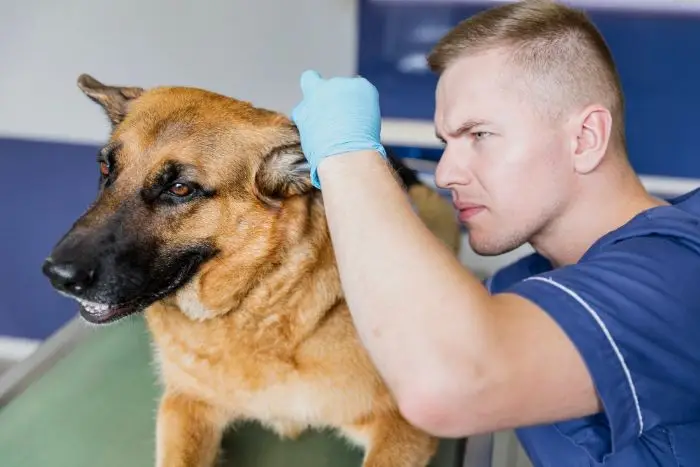Lost pets come home with Peeva.
Location Matters: Where Microchips are Placed in Your Dog and Why
As a responsible pet owner, you’re likely familiar with the concept of microchipping your dog. But beyond its basic purpose of identification, have you ever delved into the specifics of this procedure? Where is the microchip inserted in your dog, and how does it function? Understanding the details of microchip implantation can be a fascinating and important aspect of pet care, providing a crucial tool for the safety and recovery of our beloved canine companions.
Where are Microchips Placed in Dogs?
A microchip is typically implanted in a specific and standardised location on a dog – between the shoulder blades, just under the skin. This area, known as the subcutaneous tissue, is chosen for several reasons. Firstly, the area between the shoulder blades is generally less sensitive, making the procedure more comfortable for the dog. Additionally, this location minimises the chances of the microchip migrating, which can happen if implanted in other areas.
The spot between the shoulder blades is also easily accessible for veterinarians and shelter workers who scan lost pets. Since it’s a standard location, anyone who finds a lost dog can quickly scan the right area, increasing the chances of a successful identification. This universal placement has become a norm in the veterinary community, ensuring consistency in microchip scanning and reading procedures.
Anatomy and Microchip Placement
Understanding a dog’s anatomy is key in ensuring microchip implantation is both safe and effective. The area between the shoulder blades is chosen for its relatively thick layer of subcutaneous tissue. This layer, which lies just beneath the skin and on top of the muscles, is an ideal site to house the microchip. It provides enough padding to protect the chip and ensures it remains just under the skin, making it easy to locate with a scanner.
This location is also less prone to physical interference or injury. It’s an area that dogs cannot easily reach to scratch or bite, reducing the risk of irritation or infection post-implantation. Moreover, the shoulders are a less mobile area compared to other parts of the body, which decreases the likelihood of the microchip moving from its original placement.
The anatomy of a dog also dictates the depth at which the microchip is placed. The chip is implanted deep enough to stay securely in place, but not so deep that it interferes with muscle or bone. Veterinarians are trained to find this balance, ensuring the microchip is implanted correctly for optimal performance and minimal discomfort to the animal.
Where Do They Put Microchips in Dogs: The Procedure
The process of microchipping a dog is quick and relatively painless, akin to a routine vaccination. A veterinarian uses a specialised needle to insert the microchip, about the size of a grain of rice, directly under the skin in the prescribed location. The microchip comes preloaded in a sterile applicator and is injected much like a vaccine.
The dog typically does not need to be sedated for this procedure, as the discomfort is minimal and brief. The whole process takes only a few minutes. After insertion, the vet checks the microchip with a scanner to ensure it’s working correctly. This immediate verification is a crucial step to confirm the chip’s functionality.
Where are Microchips Put in Dogs: Accuracy and Safety

Accuracy in the placement of microchips is paramount for their effective detection. If a microchip is placed too superficially, it may migrate over time, ending up in a different part of the dog’s body. Conversely, if implanted too deeply, it could cause discomfort or be difficult to detect with a scanner. Veterinarians are trained to target the optimal depth for placement, ensuring the microchip remains in its designated location.
Safety is another critical aspect of the microchipping process. The needle used for implantation is slightly larger than a typical vaccination needle, which may cause a momentary discomfort. However, the procedure is generally safe, with complications being extremely rare. The most common issue is mild swelling or redness at the injection site, which usually subsides quickly.
The microchips themselves are designed to be bio-compatible, meaning they don’t cause allergic reactions or rejection by the body. They are encased in a type of glass that is compatible with living tissue, ensuring they can remain in the body for a lifetime without causing health issues.
Potential Variations in Microchip Placement
While the standard location for microchip placement is between the shoulder blades, there can be exceptions. Factors such as breed, size, or specific health concerns might prompt a vet to choose a slightly different location.
In very small breeds of puppies, a vet might place the microchip lower down the back to avoid discomfort. For large breeds with more flesh in the neck area, a higher placement might be selected for easier scanning. Additionally, if a dog has a history of skin issues or sensitivities in the standard location area, a vet may choose an alternate spot to avoid irritation.
These variations are relatively rare and are always made with the dog’s best interest in mind. The vet will balance the need for a safe, comfortable implantation with the necessity of ensuring the microchip can be easily located and scanned.
Aftercare and Monitoring Microchip Location
After a dog has been microchipped, aftercare is straightforward. Most dogs show no sign of discomfort post-procedure, and no special care is needed. Owners are advised to monitor the injection site for any signs of redness, swelling, or infection, although these are rare.
It’s a good practice for pet owners to have their dog’s microchip scanned at least once a year during a routine veterinary check-up. This annual check ensures the microchip is still functioning correctly and hasn’t migrated. Keeping a record of the microchip number is also advised, in case it needs to be referenced in the future.
The Role of Veterinarians in Microchip Placement
Veterinarians play a crucial role in the microchipping process, ensuring the implantation is performed correctly and safely. They have the expertise to assess the best location for the chip based on the individual dog’s breed, size, and health condition. Veterinarians are also responsible for educating pet owners about the process, its benefits, and any care required post-implantation.
Choosing a professional for this procedure is critical. While some microchip kits are available for non-professional use, the risk of incorrect placement and potential health complications make professional implantation the safer choice. Veterinarians have the skills and tools necessary to ensure the microchip is implanted at the correct depth and location, minimising any discomfort for the pet and ensuring the chip is easily detectable by scanners.
Microchip Scanners and Placement Efficiency
The effectiveness of a microchip scanner in detecting the chip is partly determined by the microchip’s placement. Scanners are designed to read chips implanted in the standard location between the shoulder blades. This consistency in placement across pets makes it easier for shelters, rescues, and veterinarians to quickly scan and identify lost animals.
Universal scanners, like those offered by Peeva, are adept at detecting microchips regardless of their exact placement or the frequency they operate on. Such advancements in scanner technology have further simplified the process of locating and reading microchips, making them an invaluable tool in the reunification of lost pets with their owners.
Conclusion
Microchipping your dog is a simple yet powerful way to ensure their safety. The process, involving precise and safe implantation by a veterinarian, offers peace of mind knowing that your pet can be identified if they ever get lost. Remember to have your dog’s microchip checked annually for functionality and to keep your contact information updated with the registry. Don’t hesitate to talk to your vet about microchipping if your furry friend isn’t already chipped. It’s a small step that can make a big difference in keeping your beloved pet safe.
Peeva: Where Lost Pets Find Their Way Home
Transform your pet’s microchip into a lifeline. 24/7 phone support and lost pet alerts ensure your pet gets the help they need, when they need it.






